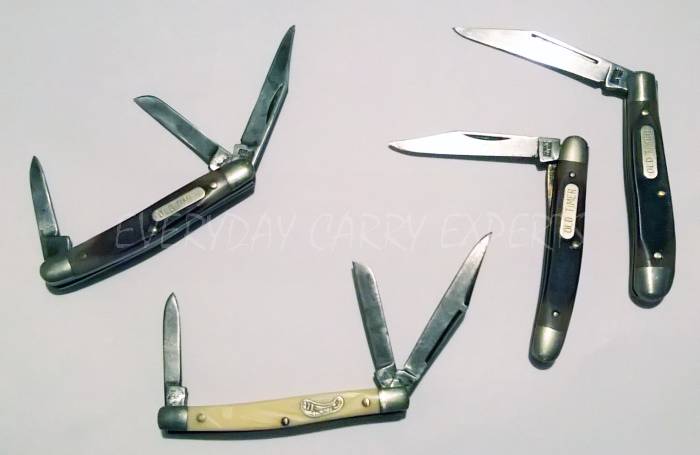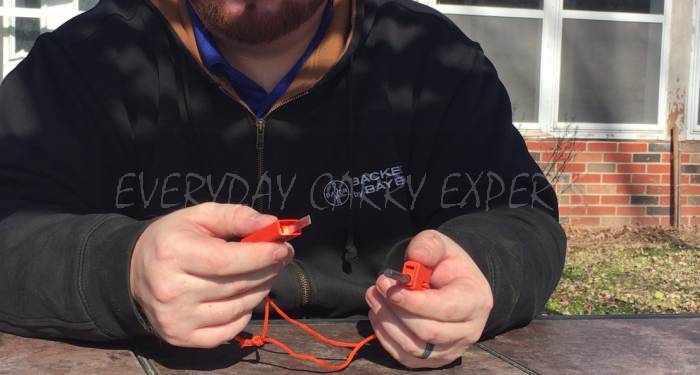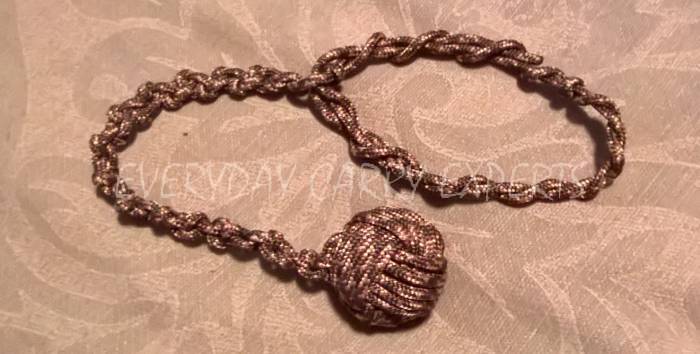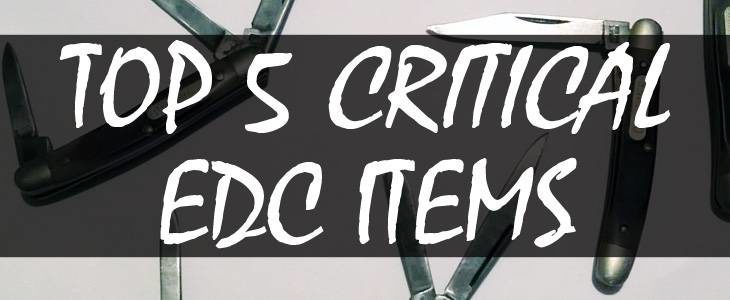When assembling an everyday carry kit, it is incredibly important to be selective regarding the items which you select. Unlike a bug out bag that can be as large and heavy as you can manage to carry, everyday carry items must be incorporated into your daily life. This means you need items that are small, lightweight, and reliable. To blend these items into your daily routine, you can either conceal them or you can choose items that appear normal for how you spend your time.
You must also keep in mind the scenarios in which you may be forced to use your everyday carry items. These are situations in which you may not be able to reach your bug out bag at home, or you may not be able to reach your get home bag in your car. This would include emergencies when at work and trapped in the building. It could be situations in which you are walking to your car or going for a jog. Maybe you are at a restaurant, a concert, a movie, or a party. These are all situations in which you would have to rely on the items that you keep with you at all times.
Can I Use a Bag for EDC?
Some preppers and survivalists keep their everyday carry kits in a gym bag, briefcase, or computer bag. This is great to give you more space for supplies, and by all means use the space. However, ask yourself if you will really take these bags with you everywhere you go? I used to carry a laptop case for my previous job, and it was next to me about 90% of the time. In my opinion, that is just not good enough.
In addition, there are situations in which your bag could be separated from you. If you are being mugged, one of the first actions the mugger may take is to confiscate your laptop. You might have your bag in the car seat next to you, but after an accident it could get thrown anywhere in that vehicle or even thrown out an open window. You need items that can be with you 100% of the time.
Be aware that staying prepared 100% of the time means exactly that. If you have five everyday carry items, those items should be with you no matter what. When you sleep they should be on you or at your bedside. When you shower they should be within reach. No matter what clothes you wear or where you go, these items should be transferred and kept within reach at all times.

Pocket Knife
In any survival situation, I consider a knife to be the tool that is absolutely essential. It is very hard to recreate a strong, sharp blade in a survival situation. With an everyday carry kit, one of your biggest priorities must be self-defense. Many of these emergency situations arise because you are being threatened by other people. Having a good knife handy is a huge advantage for defending yourself granted you know how to use it.
A knife is also useful in just about every other survival situation. If you are trapped in a car or rescuing somebody else, you can use it to cut the seatbelt. If you are starting a fire you can use it to strike a ferro rod. If building a shelter you can use it to cut wood and cordage. You can process firewood with your blade as well. Knifes can be used for hunting and trapping. You can make a spear for fishing or can use the blade to build a fish trap. There is rarely a situation in which a knife would not improve your chances of survival.
The real issue with an everyday carry knife is finding one that is both reliable and easy to conceal. I always prefer a full tang knife for reliability, but that makes it tougher to conceal. For full tang knifes, you can consider a neck knife that you wear on a necklace. They are typically flat and relatively small, so they can be concealed under any clothing. If you regularly wear boots, a boot knife is a good option. However, it would be tough to conceal if you ever wear low top shoes. There are also knives with holsters that strap to your calf just above your sock. These knives can be concealed wearing anything but shorts. However, it takes more time to pull up your pant leg and get to your blade if needed.
You can also consider folding blade knives. These allow you to carry a good sized blade in your pocket with nobody knowing the difference. The problem is that adding a joint in your blade adds a point of weakness. Also, not all folding blade knifes lock in place properly. This can be dangerous for the user.
If you are going to choose a folding blade knife, you must do the research to find one you can trust. You will also see blades that are credit card sized and fit in your wallet. I find these flimsy and tough to reach when you need them, but they might make a good backup blade.
Quick disclosure: when you click a 3rd party link on this website, and then make a purchase on that other website, we may earn a commission (at no cost to you). As an Amazon associate, I earn from qualifying purchases.

Tactical Pen
One of the best ways to add to your everyday carry kit is to pick items that can sit out in the open with nobody asking questions. A good tactical pen will look just like any other nice pen sitting on your desk, but have so much more utility in a survival situation.
Tactical pens double as another self-defense weapon for targeting pressure points on an assailant’s body. However, this weapon is allowed in areas where you cannot carry a knife. Unlike a knife, a tactical pen will likely not be used against you if you are attacked.
Ideally, tactical pens should have other uses as well. My favorite tactical pen doubles as a glass-breaker. This would allow me to shatter a side window on a car if it was on fire or submerged in water. In many cases you would not have another way to get free since your get home bag is likely in your trunk. It also has an LED flashlight built in. Having a light can be vital in a survival situation.

Fire Starter
Having a way to start fire in a survival situation is absolutely essential. There are several ways to have fire at your fingertips with your everyday carry kit. Having a lighter is the most inconspicuous item. Most people will not ask questions if they see a Bic lighter or a zippo. The zippo is windproof and can be refilled with several different flammable liquids, so between the two it would be my choice.
However, the only fire starter that is windproof, waterproof, and requires no fuel is a ferro rod. This would have to be concealed as it does not blend in well with everyday life. Either of these options would help greatly in a survival situation.

Water Filter
Next to having a fire, purifying water is the most important element of survival. There are several ways you can purify water without alerting other people. These days many people carry a water bottle with them everywhere they go. There are nice bottles you can purchase that have water filters built into the lid. In a survival situation you can scoop up some water quickly and take it with you to keep moving. Most people in your everyday life would never notice the difference. The only question is if you can keep it with you 100% of the time.
There are straw style water filters that are small enough to keep in your pocket. They are thin and lightweight, and filter water just as well as the bottle. The downside is that you cannot take water with you, and likely have to get down on your belly to drink.
You can also carry a small vial of iodine tablets to purify water. This is the smallest option, so keeping the vial concealed is not a problem. You would have to find a container in which to purify your water, and it takes about 35 minutes for the tablets to work properly.

Paracord
In both urban and rural survival situations, having cordage can be a huge advantage. It helps with building shelters, building traps, hunting, fishing, building tools, starting fire, and dozens of other applications. There are a few ways to carry cordage with you and not have it noticed. I will first state that 550 paracord is often the best cordage to carry.
You can replace your shoelaces with appropriately colored paracord. Each strand has several internal strands that are strong enough for most survival tasks. Having both laces could give you over fifty feed of total cordage.
You can also weave lanyards and bracelets out of paracord. Weaving these items can allow you to cram dozens of feet of paracord in a small package that can be concealed beneath your clothing.
Also, there are unique survival paracords that include a fire starting material, fishing line, and wire for trapping inside the cordage. This is in addition to the normal internal strands that make it so strong.
In Conclusion
For your everyday carry kit, be selective about the items you add. As stated above, find items that serve multiple purposes and that blend in with your daily life. Think about the situations you might face in which you would have no other gear available.
Once you select the right items, keep them with you at all times and you will be better prepared than just about everybody else.


I carry a lot of stuff in my pockets, probably too much for a guy with lower back problems. Regardless, my EDC consists of a multi-tool and flashlight on my belt, a Swiss Army Knife (Huntsman), .45 ACP, lighter and bandanna in my pockets. These would be my Top Five (choosing either the multi-tool or Swiss Army Knife). I wear a paracord wristband and have additional 550 cord on both of my key rings. I was just watching the Movie “Cast Away” with Tom Hanks. I love how he improvised with the stuff he scrounged up! However, survival would have been much easier if he had a knife and a lighter on him when the plane went down.